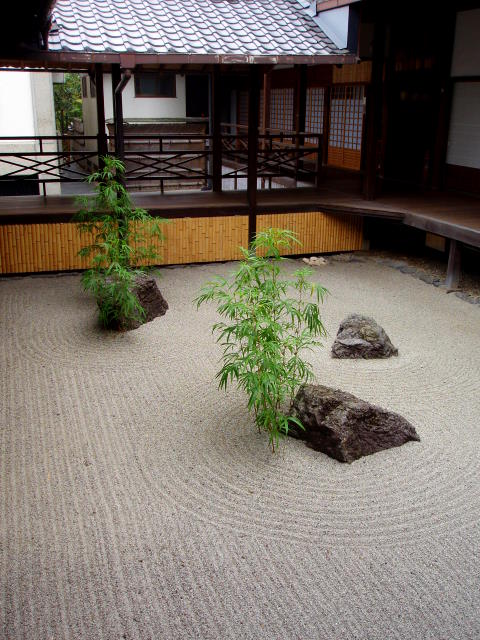
22nd October, 2006 - After an afternoon of sitting watching the history of Kyōto walking by during Jidai Matsuri, T-chan and I had decided to make our way to Shimogamo-Jinja... not that far away (or so we thought). It would be good to get some exercise... and we could stop in at Shōkoku-ji to have a look around.
Shōkoku-ji is one of the seven Rinzai “Zen” headquarters in Kyōto, and was also one the five mountains (Gozan). Whilst it looks a little subdued and doesn't appear to get that many visitors, it actually administers both Ginkaku-ji and Kinkaku-ji temples - two of the most famous temples in Kyōto (which we'll come across later). Construction commenced in 1382 AD and was completed in 1392, on orders of Emperor Gokomatsu and with the support of the third Ashikaga shogun, Yoshimitsu.
The gardens are small, but very atmoshpheric. As is often the case, you wonder how they manage to design so much ambience into such a small space. The tree looked incredible - like an over-sized ancient bansai.
It was a great place to just sit back and relax. Like many temples it was all but destroyed in the civil wars of the 15th century, during the Ōnin Wars. The current buildings date from 1807. The grounds also includes buildings of the former Imperial Palace, Kyōto Gosho.
I'm a big fan of the courtyard gardens in Kyōto, where the simple arrangement of rocks, bamboo and gravel can have such a simple pure effect. Unfortunately for me, when I try to do this, weeds are added to the equation...
The difficulty is always switching off and finding the moment of peace within.
One of it's "features" is a hall where a huge dragon (painted by Kano Mistunobu at the start of the 17th century) had been painted on the ceiling - and the amazing acoustics associated with clapping underneath it... supposedly you hear the dragon roar. You pay to enter the hall, and the guide instructs you on where to stand, looking up, you give a good old clap. Roar? Indeed, there is a lot of echo in the hall... but it's not something that left me feeling the hot breath of the dragon on my neck. Unfortunately no cameras allowed... but you can find photos around the net.
View Larger Map
By this stage we had started to run our batteries down... but we were over half way to Shimogamo-Jinja. Or so our tourist map indicated. We set off again... it was now after 4pm. Don't forget, T-chan was 2-3 months pregnant, and not exactly feeling chipper.
We almost gave up - but finding that giving up meant walking just as far backwards we continued on. We finally arrived... well after 5pm. The shrine itself is approached from the south, through the Forest of Correction (Tadasu-no-mori). Legend tells that this peaceful forest is a place where lies cannot be told. Hmmm....best to get through here in a hurry. We reached the huge vermillion torii gate with the steady passage of visitors reassuring us that we weren't too late.
Before the creation of Kyōto, there existed a number of different tribes/clans in the Kyōto basin. One such group were the Kamo, which had migrated from the Yamato region. They were living in the region where the two rivers, Kamogawa and Takanogawa converge. Shimogamo-Jinja (also known as Kamomioya Jinja) is therefore one of the oldest of the shinto shrines in Kyōto (indeed it pre-dates the city by several hundred years). The shrines enshrine Tamayori-hime and her father Kamo-Taketsunumi-no-Mikoto; the ancestors of the Kamo clan.
Shimogamo Jinja is a good example of the nagare-style in shrine design. This style was developed after the arrival of Buddhism in Japan, and was strongly influenced by Chinese architectural style.
Shimogamo Jinja is a good example of the nagare-style in shrine design. This style was developed after the arrival of Buddhism in Japan, and was strongly influenced by Chinese architectural style.
The shrine is one half of a pair... The older, sister shrine, Kamigamo Jinja (to the north west), is dedicated to the god of thunder, Wakeikazuchi. The shrines used to fall under the Shikinen Sengu, and were required to be re-built every 21 years. Nowadays however they are merely rennovated every 21 years.
The Maidono is now sometimes used for dance-recitals. Notice the nagare-style curved gables...
Time for some purification.
We felt really satisfied with ourselves, having made it all the way here...
...but about 30 seconds after this photo was taken our energy faded completely, with the last rays of sunlight. The journey back to the apartment was very quiet - we were completely spent. No time for going out tonight...













again with the awesome pictures making get high on Japan, now the 1 year before I get there seems so far away!
ReplyDeleteThnx...1 year is not so far away.... the months seem to pass very quickly these days.
ReplyDelete